
The Himalayas, or Himalaya, is a mountain range in Asia, separating the plains of the Indian subcontinent from the Tibetan Plateau. The range has some of the Earth's highest peaks, including the highest, Mount Everest; over 100 peaks exceeding elevations of 7,200 m (23,600 ft) above sea level lie in the Himalayas.

The Khajuraho Group of Monuments are a group of Hindu and Jain temples in Chhatarpur district, Madhya Pradesh, India. They are about 175 kilometres (109 mi) southeast of Jhansi, 10 kilometres (6.2 mi) from Khajwa, 9 kilometres (5.6 mi) from Rajnagar, and 49 kilometres (30 mi) from district headquarter Chhatarpur. The temples are famous for their Nagara-style architectural symbolism and a few erotic sculptures.

Haridwar is a city and municipal corporation in the Haridwar district of Uttarakhand, India. With a population of 228,832 in 2011, it is the second-largest city in the state and the largest in the district.

Badrinath is a town and nagar panchayat in Chamoli district in the state of Uttarakhand, India. It is a Hindu holy place, and is one of the four sites in India's Char Dham pilgrimage. It is also part of India's Chota Char Dham pilgrimage circuit and gets its name from the Badrinath Temple.

Lake Mansarovar, also called Mapam Yumtso locally, is a high altitude freshwater lake fed by the Kailash Glaciers near Mount Kailash in Burang County, Ngari Prefecture, Tibet Autonomous Region, China. The lake along with Mount Kailash to its north are sacred sites in four religions: Hinduism, Jainism, Buddhism and Bön.
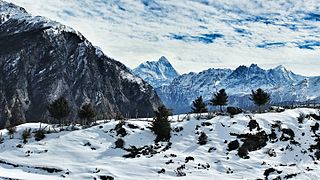
Uttarakhand, also known as Uttaranchal, is a state in northern India. It is often referred to as the "Devbhumi" due to its religious significance and numerous Hindu temples and pilgrimage centres found throughout the state. Uttarakhand is known for the natural environment of the Himalayas, the Bhabar and the Terai regions. It borders the Tibet Autonomous Region of China to the north; the Sudurpashchim Province of Nepal to the east; the Indian states of Uttar Pradesh to the south and Himachal Pradesh to the west and north-west. The state is divided into two divisions, Garhwal and Kumaon, with a total of 13 districts. The winter capital of Uttarakhand is Dehradun, the largest city of the state, which is a rail head. Gairsain, a town in Chamoli district, is the summer capital of Uttarakhand declared on 5 March 2020. The High Court of the state is located in Nainital, but is to be moved to Haldwani in future.
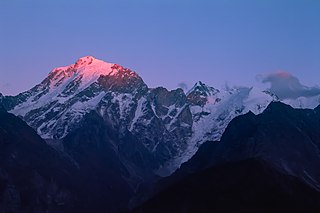
North India is a loosely defined region consisting of the northern part of India. The dominant geographical features of North India are the Indo-Gangetic Plain and the Himalayas, which demarcate the region from the Tibetan Plateau and Central Asia.

A matha, also written as math, muth, mutth, mutt, or mut, is a Sanskrit word that means 'institute or college', and it also refers to a monastery in Hinduism. An alternative term for such a monastery is adheenam. The earliest epigraphical evidence for mathas related to Hindu-temples comes from the 7th to 10th century CE.

Kedarnath Temple is a Hindu temple, one of the twelve jyotirlinga of Shiva. The temple is located on the Garhwal Himalayan range near the Mandakini river, in the state of Uttarakhand, India. Due to extreme weather conditions, the temple is open to the general public only between the months of April and November. During the winters, the vigraha (deity) of the temple is carried down to Ukhimath to be worshipped for the next six months. Kedarnath is seen as a homogenous form of Shiva, the 'Lord of Kedarkhand', the historical name of the region.

Baijnath is a small town on the banks of the Gomati river in the Bageshwar district in Kumaon division of Uttarakhand, India. The place is most noted for its ancient temples, which have been recognized as Monuments of National Importance by the Archaeological Survey of India in Uttarakhand. Baijnath has been selected as one of the four places to be connected by the 'Shiva Heritage Circuit' in Kumaon, under the Swadesh Darshan Scheme of the Government of India.
Jageshwar is a Hindu pilgrimage town near Almora in Almora district of the Himalayan Indian state of Uttarakhand. It is one of the Dhams in the Shaivism tradition. The site is protected under Indian laws, and managed by the Archaeological Survey of India (ASI). It includes Dandeshwar Temple, Chandi-ka-Temple, Jageshwar Temple, Kuber Temple, Mritunjaya Temple, Nanda Devi or Nau Durga, Nava-grah temple, a Pyramidal shrine, and Surya Temple. The site celebrates the Jageshwar Monsoon Festival during the Hindu calendar month of Shravan and the annual Maha Shivratri Mela, which takes place in early spring.
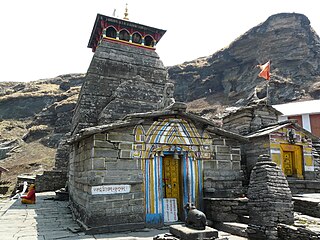
Tungnath (IAST:tuņgnāth) is one of the highest Shiva temples in the world and is the highest of the five Panch Kedar temples located in the Rudraprayag district, in the Indian state of Uttarakhand. The Tungnath mountains form the Mandakini and Alaknanda river valleys. It is located at an altitude of 3,690 m (12,106 ft), and just below the peak of Chandrashila. It has a rich legend linked to the Pandavas, heroes of the Mahabharata epic.
The Katyuri kings were a medieval Hindu Rajput's ruling clan of Khasha origin from Joshimath that ruled over the regions in present day regions of Kumaon, Uttarakhand in India and parts of Doti/Sudurpashchim Province in Nepal from 700 to 1200 CE. The founder of this dynasty, King Vasu Dev was originally a Buddhist ruler, but later he started following Hindu practices sometimes attributed to a vigorous campaign of Hindu philosopher Adi Shankara.

Dr. Shekhar Pathak is a historian, editor, publisher, activist, and traveller from Uttarakhand, India. He is known for his extensive knowledge of the history of colonial and postcolonial social movements and contemporary environmental and social issues in Uttarakhand, and colonial exploration in the Himalayas and Tibet. He has also been engaged in activism for various social and environmental causes since the 1970s.

Panch Kedar refers to five Hindu temples or holy places of the Shivaite sect dedicated to god Shiva. They are located in the Garhwal Himalayan region in Uttarakhand, India. They are the subject of many legends that directly link their creation to Pandavas, the heroes of the Indian epic Mahabharata.
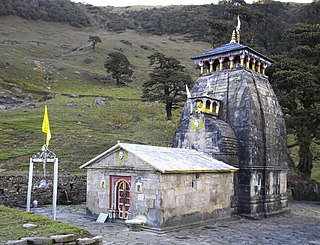
Madhyamaheshwar or Madmaheshwar is a Hindu temple dedicated to Shiva, located in Gaundar, a village in the Garhwal Himalayas of Uttarakhand, India. Situated at an elevation of 3,497 m (11,473.1 ft), it is one of the Panch Kedar pilgrimage circuits, comprising five Shiva temples in the Garhwal region. The other temples in the circuit include: Kedarnath, Tungnath and Rudranath which are culturally visited before Madhyamaheshwar and, Kalpeshwar generally visited after Madhyamaheshwar. The middle (madhya) or belly part or navel (nabhi) of Shiva is worshipped here. The temple is believed to have been built by the Pandavas, the central figures of the Hindu epic Mahabharata.
Michael W. Meister is an art historian, archaeologist and architectural historian at the University of Pennsylvania. He is the W. Norman Brown Professor in the Department of History of Art and South Asia Studies, and has served as chair of the Department of South Asia Studies and as the director of the University of Pennsylvania's South Asia Center. In addition, he is Consulting Curator, Asian Section, University of Pennsylvania Museum of Archaeology and Anthropology, and Faculty Curator of the South Asia Art Archive within the Penn Library's South Asia Image Collection.
Uttarakhand is a state in the northern part of India. It is often referred to as the "Devbhumi" due to its religious significance and numerous Hindu temples and pilgrimage sites found throughout the state. As a result, religious tourism forms a major portion of the tourism in the state. Uttarakhand is known for the natural environment of the Himalayas. 2019 Tourist Arrivals Domestic – 40,000,000 per/year and Foreigner – 150,000 per year. Tourism business in Uttarakhand generated ₹ 23,000 crores during 2013–14.

The Masrur Temples, also referred to as Masroor Temples or Rock-cut Temples at Masrur, is an early 8th-century complex of rock-cut Hindu temples in the Kangra Valley of Beas River in Himachal Pradesh, India. The temples face northeast, towards the Dhauladhar range of the Himalayas. They are a version of North Indian Nagara architecture style, dedicated to Shiva, Vishnu, Devi and Saura traditions of Hinduism, with its surviving iconography likely inspired by a henotheistic framework.
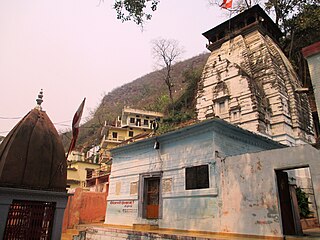
Raghunathji Temple in Devprayag, a pilgrimage town in Tehri Garhwal district in Himalayas in the North Indian state of Uttarakhand, is dedicated to Vishnu. It is located 73 km from Rishikesh on the Rishikesh–Badrinath highway. Constructed in the Deula style, the temple is glorified in the Nalayira Divya Prabandham, the early medieval Tamil canon of the Alvar saints from the 6th–9th centuries CE. It is one of the 108 Divyadesam dedicated to Vishnu, who is worshipped as Raghunathji (Rama) and his consort Lakshmi as Sita.















